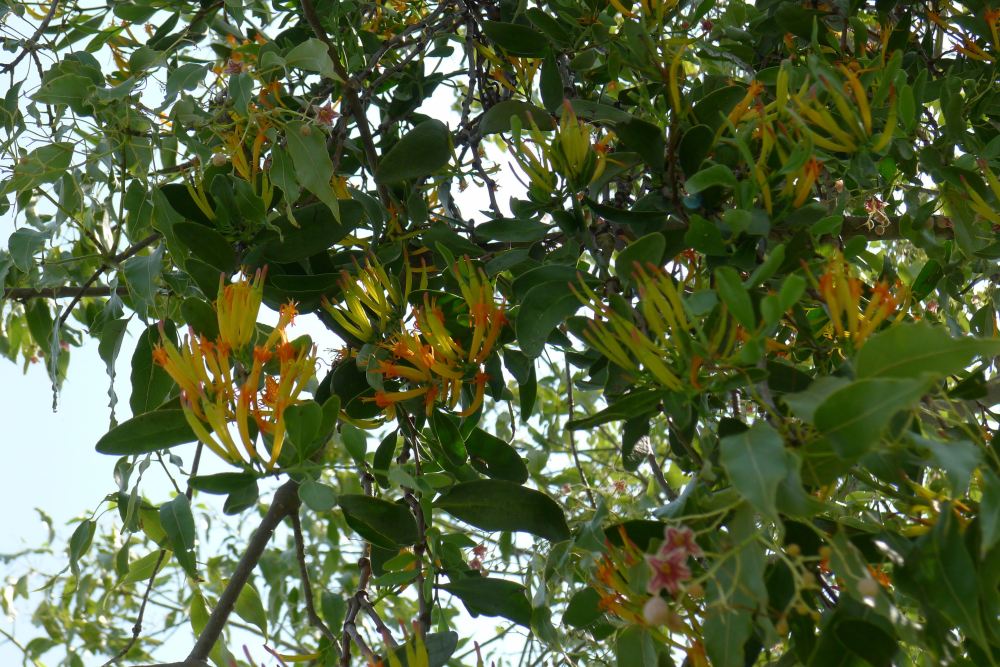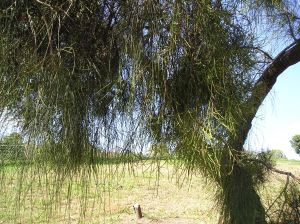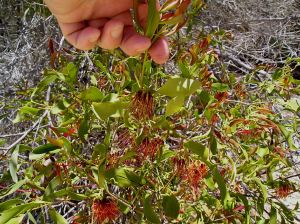
Parasites aren’t all bad, and mistletoes deserve a rethink. If you observe them, you’ll discover a range of interdependent animals depend on these valuable and fascinating Australian plants. Adult gardeners almost always react negatively towards parasitism, missing out on learning about the wonderfully interconnected, interdependent world in which we cultivate plants. Thanks to Northern Slopes Landcare, I met some keen young gardeners at Gravesend Public School in NSW, and their response to mistletoe growing in the school grounds was positive. Young gardeners are almost always willing to learn and grow.
True parasites are rarer than you think
True plant parasites (‘holoparasites’) derive all their nutrition from a host plant. Having ditched the need to photosynthesise, they often lack chlorophyll and look pale. By contrast, semi-parasites (‘hemiparasites’) are much more commonly encountered. These plants indulge in a little parasitism and also practise photosynthesis.
A plant parasite’s ideal home is a plant with a 24/7 sap flow. A hemiparasite gets some of its organic nourishment from the host by plumbing themselves into branches. This eliminates the need for conventional roots.
Other interactions are less obvious, but even more important to the health of a plant. Few conventional plants exist without mycorrhizal associations in their root systems. Even orchids growing on trees have mycorrhiza. A mycorrhiza is a symbiotic association composed of a fungus and roots of a vascular plant. The fungus colonizes the host plant’s roots, either growing within the cells (intracellular) or growing on the exterior of the root (extracellular) or as an arbuscular mycorrhizal fungus. The latter is totally, inextricably intertwined with living plant tissue and cannot be removed or cultured outside its host plant.
Mycorrhizal fungi form a vital part of soil life, soil chemistry, plant health and plant nutrition. They form a massive extension of a conventional plant’s functional root system, fungal threads (hyphae) link the roots systems of neighbouring plants – which may or may not have any botanical relationship to each other – into one vast, almost infinitely complex web of interdependent life. And so those parasites, of every shade of green, are effectively plumbed into this network.
The association between plants and mycorrhizae is almost always mutually beneficial (symbiotic) so the presence of a hemiparasite on a plant is simply one additional living relationship.
Childhood gardening lessons
Ronald Connor, my grandfather, gardened in England during the 20th century, an era when soil science was only beginning to grasp the intimate associations between plants, fungi and soil.
Ron taught me that one way you could increase the strike rate of ‘difficult to root’ conifer cuttings was to innoculate the propagating mix with soil gathered from around the base of the mother plant. This introduced mycorrhizal fungi into the growing medium. But Ron didn’t know the name or the function of what he was ‘seeding’ the growing medium with, he just knew from experience that it helped cuttings grow roots and become new plants. Once the fungus enters the tissue of the cutting, usually through the developing callus, the symbiotic relationship is established and the cutting thrives.
Similarly, Ron taught me that in order to increase your chances success with sowing orchid seed (tricky at the best of times for an amateur because orchid seed is hard to handle and seedlings are vulnerable to disease) you needed to sow the seed around the base of the mother orchid – where the mycorrhizal fungi were present – and to prick out and pot up individual seedlings a year later.
Living outdoor classrooms
Most plants we lump together as ‘parasites’ are semi-parasitic. Of these, the mistletoes are the most abundant and they have an undeserved bad reputation. Australia has ninety or so species, seventy odd of which are endemic, occurring nowhere else on Earth.
The fruit are generally brightly coloured and the flesh is sweet and tasty. Each fruit has one large seed and is covered with a sticky coat. Birds enjoy the fruit but have to wipe the seed, either off their beaks or bottoms, onto a branch after feeding. The seed then rapidly germinates, sending a root into the host plant and plumbing itself into the sap flow.

Mistletoes grow in a wide range of trees. Some of their favourites include eucalypts, banksias, wattles, mangroves and casuarinas. If you want to look for them, you’ll have to look up in the canopy because that’s where most of them grow. Sometimes it can be difficult to see them because their leaves often mimic the foliage of their host tree.
Last week at Gravesend Public School (NSW) I discussed the value of managing biodiversity with the students, including the fact that most animals are neither friends or enemies of farmers and gardeners – they are simply biodiversity, creatures that live alongside us. The idea of managing biodiversity, I explained, is to grow the right kinds of flowers to attract beneficial insects to pollinate crops and control pests. Any help like this reduces the need to spend time, money and resources on pest control, and consequently this increases farm profits and decreases the cost of growing.
We then went on a ‘bug hunt’ in the school grounds looking for insect life and deciding if what we found was a friend, an enemy, or part of the general, harmless biodiversity. I also gave them a challenge: try to identify the most important plant on the site for encouraging biodiversity.
It took all of five minutes for them to locate a beautiful young specimen of Kurrajong (Brachychiton populneus), in full bloom, carrying an Orange mistletoe (Dendropthoe glabrescens) also in bloom.
The Kurrajong flowers attracted a wide range of insects, from ants to beetles. The foliage can be fed to stock during drought and the trees are useful for cooling dry gardens with their shade. This is a valuable tree for attracting biodiversity and beneficial insects, like wasps. The bark attracts a range of small spiders, mantids, bugs and lichens.
Lichen is a composite life-form, a symbiotic association between a fungus and an alga, and they are responsible for fertilising the soil around the trees they grow on. They add another layer to the complex web of life.
Orange mistletoe occurs from NSW northwards to Cape York and west into WA. It also occurs in Indonesia and PNG. The colourful flowers on the one in the school grounds was attended by four mistletoe birds (Dicaeum hirundinaceum). They know highly nutritious nectar when they find it.
Mistletoe birds are most famous for eating mistletoe fruit and for spreading its seed. The mistletoe bird has almost no gizzard – their digestive system has become almost a uniform duct which maximises the volume of berries to pass quickly through. The sticky seeds are voided in under half an hour of being eaten – it’s fast food. If the seeds end up on a suitable tree, they usually germinate.
Aborigines once ate mistletoe fruit as treats – they are the original sweets for kids. Lorikeets and cockatoos drink mistletoe nectar, and possums eat the flowers and leaves. Mistletoe leaves and flowers often provide a far more concentrated and digestible source of nutrition than the host they grown on. Every animal that feeds on mistletoe usually leaves droppings which then help fertilise the soil around host tree. Just like mycorrhiza and lichen, mistletoes help cycle nutrients, feeding the topsoil, only in a more significant and localised way.
Orange mistletoe is one of the most valuable butterfly host plants anyone could ask for. It is the host plant for the Amethyst Jewel, Black Jezabel, Golden Jezabel, Red-banded Jezebel, Scarlet Jezabel, Silky Jewel, Golden Azure, Orange-tipped Azure, Southern Purple Azure and Northern Purple Azure butterflies and Syntherata leonae, a species of moth.
Contrary to their undeserved bad reputation, mistletoes are important. Their flowers, fruit, nectar and leaves are all highly nutritious and a wide range of wildlife depends on them for food, including koalas, sugargliders, possums, birds and insects.
The greater the diversity of mistletoe species found within a forest is an indicator of its overall health. In more disturbed ecosystems, like roadside vegetation, fewer mistletoe species occur and they may occur in larger numbers. In cities, where unnaturally high populations of possums occur, these hungry marsupials are responsible for eliminating mistletoe plants. Possums help keep city trees relatively mistletoe-free.
Drought-affected trees and mistletoe
Trees carrying large numbers of mistletoe sometimes die. It’s a common misconception that the mistletoe is to blame.
Mistletoes are not adapted to drought and are often succumb to moisture stress well before their host tree. When a tree full of mistletoe dies, it is most often because the tree is already under environmental stress.
In a home or farm garden, never feed a stressed tree with fertiliser. This often accelerates death. You can provide stressed trees with micronutrients (aka trace elements), making sure to follow the instructions on the pack. Micronutrients must be used sparingly because they are only needed in minuscule amounts – too much can be damaging.
If half, or more than half of the tree’s remaining ‘canopy’ is mistletoe foliage, thinning the mistletoe may help recovery. To remove individual mistletoe plants, prune the branch off behind the point of attachment.
Each pruning cut allows the tree to lose moisture, so water the tree deeply afterwards. Mulch under the canopy. Spread a 5 – 10cm deep layer of organic mulch (leaves, hay, dried grass, powerline prunings, cow or sheep manure or compost) under the canopy. Mulching is critical if a tree is pruned, because pruning permits extra sunlight to reach, warm up and dry out the soil.
During ongoing drought, periodically water trees deeply with seaweed solution. Seaweed is ‘multivitamins’ for plants, but it also encourages composting, it enhances the wettability of hydrophobic soil and, importantly, stimulates mycorrhiza which in turn contribute to plant health. If you can’t afford seaweed, use molasses solution (1/2 to 1 cup molasses to 4.5 litres water covers 3 – 4 sq metres soil).
True parasites

True parasites, such as Dodder Vine (Cuscuta spp.), totally rely on the plant they’re growing on for nourishment. Dodders are threadlike plant parasites. They start life as seed and need to rapidly find a host before the nourishment stored in the seed embryo is exhausted. Dodders lack leaves and chlorophyll and once they have plumbed themselves into their host, their roots die and they acquire all their nourishment from their host plant.
Some species are nuisances but others, like introduced American Dodder vine, Cuscuta campestris, can become serious crop pests. American Dodder vine is widespread in Australia, weakening and sometimes killing plants. It feeds on a very wide range of crops. It often evades detection in home and community gardens because in its early stages it doesn’t look threatening. Don’t be fooled – this is a declared weed and must be controlled.
All Dodder vines are short-lived, but they seed prolifically. Control by removing every piece of vine, clear the ground and then mulch to a depth of 10 – 15cm. Dispose of waste by burying 0.5m deep, or burning, or by drowning in water for about a month.
Seed are short-lived, so where crops have been badly attacked, leave the ground mulched for one season – this can be spring, summer or autumn – and this will suppress any germinating seed.

There’s a brief Mistletoe factsheet on the Gardening Australia website from when I recorded a segment for Series 21 Episode 41 on mistletoes in Bayside Brisbane, 04/12/2010.
“Parasites aren’t all bad, and mistletoes deserve a rethink. If you study them, you’ll discover that they’re fascinating Australian plants making a valuable contribution to the environment.”
My thanks to Northern Slopes Landcare Association Inc. for inviting me to their region and allowing me to meet the students at Gravesend Public School. After our session there, I think their Orange mistletoe has earned greater appreciation, and that makes me very happy.
Jerry Coleby-Williams
24th November 2015
Great article Jerry, thank you.
Glad that you pointed out that our insect and animal visitors to the garden are just part of the natural bio-diversity – part of a healthy garden. I’ve met many who consider their garden fauna has to be “controlled”. They ask, “What is this? Should I kill it?”.
Also good info on mycorrhiza (one day I’ll learn to spell it correctly – always have to cut and paste!).
I have been endeavouring to ‘plant’ some mistletoe in my butterfly garden but as yet none have taken. I’ll keep at it. http://www.buterflyhostplants.com.au
excellent article Jerry, thank you.
Love reading your stories Jerry Informative as usual. :>)